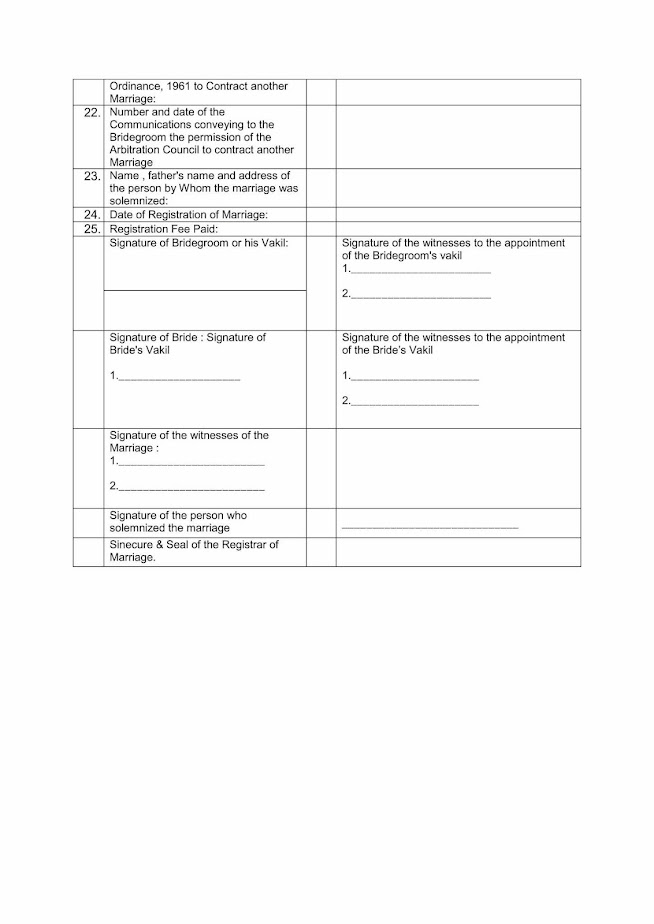
“I wish my parents had the courage to contest that. “My in-laws specifically asked us to mention Rs10,000 as my mehr,” shares Abida. Such was the case of nurse Abida Mohsin who resents her parents’ decision regarding her haq mehr, even after four years of marriage. Many parents feel ashamed to demand a specific amount and therefore, ignore the slots in that pertain to it without realising that this could lead to several problems between the couple in the future. In general, the issue of haq mehr is resolved by the elders, usually the fathers of the bride and the groom. Unless the mehr is specifically mentioned in the nikahnama, the gold remains a gift in the eyes of the law and must be returned in case of a divorce. If gold worth a certain amount is specified, the bride can automatically claim that gold from her bari (gifts given by the groom and his family) as her own.

Points 12 to 17 of the document elucidate the details of the amount that the families have mutually agreed upon, which can be paid in the form of cash, gold or any other valuable item. Not only should you be well aware of the purpose and importance of the haq mehr, it is also advisable for the two families to discuss and finalise it beforehand to avoid any grievances at the last minute. One of the most important clauses purported by the nikahnama is that of the haq mehr - an obligatory gift given by the groom to his bride, in consideration of the marriage. The points ask for the names, birthdates, addresses and national identity card numbers of the three representatives, along with a specification of the relationship shared between the bride and groom and each of their two witnesses. The witnesses must include two trustworthy Muslim men who are not next of kin to the bride, eg ascendants like the father or grandfather and descendants like the son or grandson. As per Islamic tradition, the couple gives consent to one representative (each) known as the vakil to conduct the ceremony in the presence of two witnesses (from each side) and the stipulated dowry (if applicable). The next few points on the document (number 7 to 11) refer to the representatives appointed by the couple to bear witness to their nikah. “Although my real age upon marriage was 26, my parents felt that it was much too old so they cut off four years of my existence.” “I was born in 1960 but my nikahnama says 1964,” admits homemaker Nilofer Asghar. The age of a bride is source of great trepidation in many parts of Pakistan, particularly in the rural areas, where an unmarried girl past her marriageable age is brought in for a nikah. Despite the law, many nikahs are conducted with blank or incorrectly filled age slots. Similarly, if the marriage takes place through the court, she must be at least 18. There is a special focus on the age of the bride upon marriage as she should be at least 16 years old for it to be accepted legally (the groom must be 18 or above). Years later, if either of the two parties feel that their partner isn’t abiding by the principles of the nikahnama, the matter can be protested in court.Ī typical nikahnama begins with basic profiling of the bride and groom, asking for their names, address and relationship statuses. It is especially important for the bride to align each detail with her partner in order to safeguard her position in the marriage. A sound knowledge of the nikahnama can actually help the couple understand expectations and their duties towards one another. Little or no consideration is given to the terms and conditions the nikahnama includes couples commence their new lives together unaware of their marital rights.Īlthough seemingly simple, your nikahnama deserves some attention and analysis before you sign it. In fact, many families leave the nikah at the mercy of a maulvi who is hired to conduct the ceremony and fills the form as he sees fit. Once you put your name on the dotted line, there is no looking back and, yet, most couples only see the document seconds before it renders them man and wife. Unfortunately, in the quest for making their wedding memorable, the bride and groom often overlook the one tiny detail which, as it happens, will seal their impending marriage: the nikahnama.ĭon’t underestimate this dull-looking, often poorly-printed document as it is perhaps the most important piece of paper you will ever hold in your life.

Right from the time that the wedding dates are finalised up to the actual event, both sets of families are engrossed in a flurry of excitement and activity.įrom bridal outfits and dances to the planning, decoration and implementation of the venue - people invest all their energy into perfecting their event, right down to a tee.

Weddings in Pakistan are an interesting affair.


 0 kommentar(er)
0 kommentar(er)
